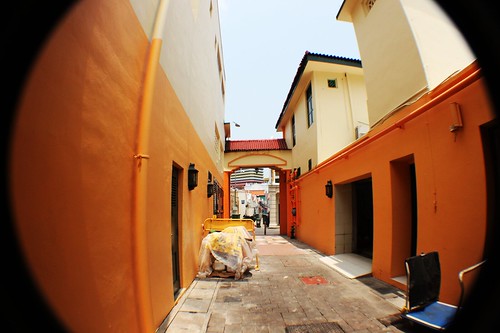I’ve lived here all my life, but never had I seen so much color in Singapore – bright orange columns against the dirty cream of signs reading “Internet Café, 24 hours” with blinking neon arrows. As I walked towards the ethnic neighbourhood of Little India, the gravel beneath my sneakers slowly fell away to a tessellation of orange diamonds, and the public housing shrank to traditional shophouses, standing in full glory from red windows, to turquoise walls, and striped patio blinds. Some of the older ones had traditional long colonial windows that swung open like doors.

Passing by the famed Mustafa Centre, I noticed a common advertisement written in Hindi, and all around me people conversing in a mix of English and foreign tongues – arguing about the price of almost everything, from the (now almost) defunct payphone cards, to bracelets, and patterned cloth tote bags. Somewhere along the way, I caught the distinct scent of spice and curries, of biryani and prata, and gravitated to the entrance of the restaurant, as if the smell alone could satiate my hunger. Many other similar ones appeared along the way as well, calling claim to cuisines from Pakistan to Bengal, and all across the Indian subcontinent. Pulling myself away from the food, I worked my way through the narrow corridors that separated the stores and the road, the heavy beats of popular Bollywood movies blaring from the speakers and throbbing in my head.
I found myself confronted by the greatest array of saris, from turquoise cloths with gold embellishments, to richer varieties of a deeper red. “How much are those up there?” I ask, in reference to the saris that are kept on display on the walls, away from the prying and longing hands of customers. He only smiles, and I move on. Just a couple of steps later, I notice a folding wooden table with a red cloth covering it, and an album of henna (traditionally known as mehandi) designs. These intricate patterns come from the application of henna paste to the skin using one of the plastic cones on the table, and will create somewhat of a temporary tattoo, usually on one’s skin or hands.
Turning down an alley, I walked through tented stalls cramped together on the edge of the road, selling everything from flower garlands, to jothi, to vegetables. I stopped. In the baskets beside the carrots and potatoes, there were tiny eggplants and bitter melons that were only the length of a finger. Some were even as small as golf balls. Putting the vegetables back in place, I walked on through the alley, where posters were flapping in the wind, struggling desperately to cling on to the peeling walls. Along the sidewalk, there were stacks of thin mattresses, overturned wooden chairs, and sofas missing their cushions. There was even the occasional piece of furniture wrapped in plastic, as if waiting for someone to come along and to pick it up. It was a mosaic of baby’s strollers, bicycles, bags, and even shopping carts. At the end of the sidewalk, a man walked with a chair towards the heap of what appeared to be discarded goods. He took his time, selecting the best spot, before positioning the wooden chair neatly against a stack of mattresses. He wasn’t hasty to leave.
When I turned to point my camera down an alley, there was a holler, and I saw in my viewfinder three men storming towards me, threatening to rip my camera apart.
I ran and ran, once again through the colors of Little India, through diversity, reliving every bit of the sounds, the sights, and the smells.
Jiawen Pek is a member of the Youth Travel Blogging Mentorship Program.
Photo courtesy and copyright Jiawen Pek
